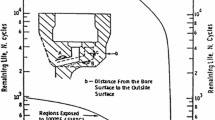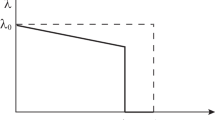Abstract
The service life of aircraft structural components undergoing random stress cycling was analyzed by the application of fracture mechanics. The initial crack sizes at the critical stress points for the fatigue crack growth analysis were established through proof load tests. The fatigue crack growth rates for random stress cycles were calculated using the half-cycle method. A new equation was developed for calculating the number of remaining flights for the structural components. The number of remaining flights predicted by the new equation is much lower than that predicted by the conventional equation.
This report describes the application of fracture mechanics and the half-cycle method to calculate the number of remaining flights for aircraft structural components.
Résumé
On a analysé en application de la mécanique de rupture la vie en service de composants de structures aéronautiques soumis à une sollicitation cyclique aléatoire. A l'aide d'essais à la charge d'épreuve, on a établi les dimensions initiales d'une fissure aux points critiques de sollicitation, pour analyser sa croissance par fatigue.
Les vitesses de croissance d'une fissure de fatigue dans le cas des charges aléatoires ont été calculées par la méthode des demi-cycles. On a mis au point une nouvelle expression pour calculer le nombre d'heures de vol résiduelles pour des éléments de structure. S'il résulte de cette nouvelle expression, ce nombre est beaucoup plus faible que celui prédit par les équations de vie résiduelle conventionnelles.
Similar content being viewed by others
References
D.R. Donaldson and W.F. Anderson, in Proceedings of the Crack Propagation Symposium, Vol. 2, Cranfield, (September 1961).
J.P. Butler, The Material Selection and Structural Development Process for Aircraft Structural Integrity Under Fatigue Conditions. AFFDL-TR-70-144, Conference Proceedings, Air Force Conference, Miami, Florida, December 15–16, 1969.
W. Astley and J. Scott, Engineering Practice to Avoid Stress Corrosion Cracking. (The Environment Encountered in Aircraft Service.) AGARD Conference Proceedings No. 53.
R.G. Forman, V.E. Kearney and R.M. Engle, Journal of Basic Engineering, Transactions ASME, D89 (1967) 459.
E.K. Walker, The Effect of Stress Ratio During Crack Propagation and Fatigue for 2024-T3 and 7075-T6 Aluminum, Effects of Environments and Complex Load History on Fatigue Life. ASTM STP 462 (1970) 1.
J. Schijve, Engineering Fracture Mechanics, 11 (1979) 167–221.
W.L. Starkey and S.M. Marco, Transactions ASME (1957) 1329–1336.
C. Incarbone, in Fatigue of Aircraft Structures, Proceedings of the Symposium held in Paris, 16th–18th May 1961, W. Barrois and E.L. Ripley (eds), Pergamon Press, New York (1963) 209–217.
S.H. Smith, in Acoustic Fatigue in Aerospace Structures, Syracuse University Press (1965) 331.
William L. Ko, Alan L. Carter, William W. Totton and Jules M. Ficke, Application of Fracture Mechanics and the Half-Cycle Method to the Prediction of Fatigue Life of B-52 Aircraft Pylon Components. NASA TM-88277 (1988).
William L. Ko and Lawrence S. Schuster, Stress Analyses of B-52 Pylon Hooks. NASA TM-84924 (1985).
Author information
Authors and Affiliations
Rights and permissions
About this article
Cite this article
Ko, W.L. Application of fracture mechanics and half-cycle theory to the prediction of fatigue life of aerospace structural components. Int J Fract 39, 45–62 (1989). https://doi.org/10.1007/BF00047439
Received:
Accepted:
Issue Date:
DOI: https://doi.org/10.1007/BF00047439




